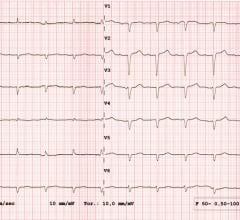July 28, 2023 — GE HealthCare is recalling malfunctioning TruSignal sensors that may reduce the amount of energy sent to ...
Cardiac Diagnostics
This channel includes news, videos, podcasts and other content on new technology innovations for cardiac diagnostic systems and techniques. This includes laboratory testing, blood tests including troponin testing, electrocardiogram (ECG) systems, point of care testing systems, genetic testing, cardiac patient monitoring devices including wearable sensors, and studies showing new ways to diagnose heart diseases.
July 28, 2023 — The Society of Thoracic Surgeons has launched its next-generation Operative Risk Calculator to assess ...
July 27, 2023 — Heart Test Laboratories, Inc. d/b/a HeartSciences, an artificial intelligence (AI)-based medical ...
Cardiac PET/CT represents a major advancement in cardiovascular diagnostics, offering significant clinical and ...
July 21, 2023 — AliveCor, a leading innovator in FDA-cleared personal electrocardiogram (ECG) technology, today ...
July 19, 2023 — The U.S. Food and Drug Administration (FDA) is recommending health care providers, laboratory personnel ...
July 18, 2023 — The U.S. Food and Drug Administration (FDA) has issued a Class I recall on Quidel Cardiovascular is ...
When the patients of Michael Boler, M.D. need cardiac monitoring, the Holter monitor is no longer his first choice. “The ...
July 18, 2023 — The TIMELY consortium announced today the enrollment of the first patient in the randomized controlled ...
July 11, 2023 — FIRE1 announced that the first U.S. patients have been successfully implanted with its FIRE1 System for ...
July 5, 2023 — Heart health risks emerge early in life in American Indian/Alaska Native (AI/AN) women and are increased ...
When the patients of Michael Boler, M.D. need cardiac monitoring, the Holter monitor is no longer his first choice. “The newer ECG devices we have now are so much less cumbersome. It’s like wearing a Band-Aid versus carrying a bulky device,” said the Greenwood, Mississippi internist. “My patients prefer the more comfortable, wire-free form factor, and the quality is as good as, or better, than the Holter,” continued Boler. “Plus, my patient compliance has increased. With the Holter, the leads sometimes come off. The patient may think the device isn’t working, so they take it off and we have to restart the process.”
June 21, 2023 — Anumana, Inc., a leading AI-driven health technology company, has received Breakthrough Device ...
June 21, 2023 — Qardio, a leading innovator in healthcare technology, has unveiled its groundbreaking Livestream ...
June 19, 2023 — AliveCor, a global leader in personal electrocardiogram (ECG) technology, has announced a groundbreaking ...
Sudden cardiac death (SCD) is the leading medical cause of death in young athletes and its impact is consistent worldwide. Most professional athletes in the United States are required to take part in comprehensive cardiovascular screening programs to identify often-asymptomatic congenital or inherited heart disorders, and other cardiac risk factors. There remains a debate however, whether to mandate ECGs as part of pre-participation screening programs for student athletes at the collegiate and high school levels or even at younger ages.
June 14, 2023 — Vigorous exercise does not appear to increase the risk of death or life-threatening arrhythmia for ...
June 13, 2023 — A recent study highlights that implantable cardioverter-defibrillator (ICD) patients with new-onset ...

The global cardiovascular diagnostic and monitoring devices market was valued at $14.2B in 2021 and is projected to ...


 July 28, 2023
July 28, 2023
















